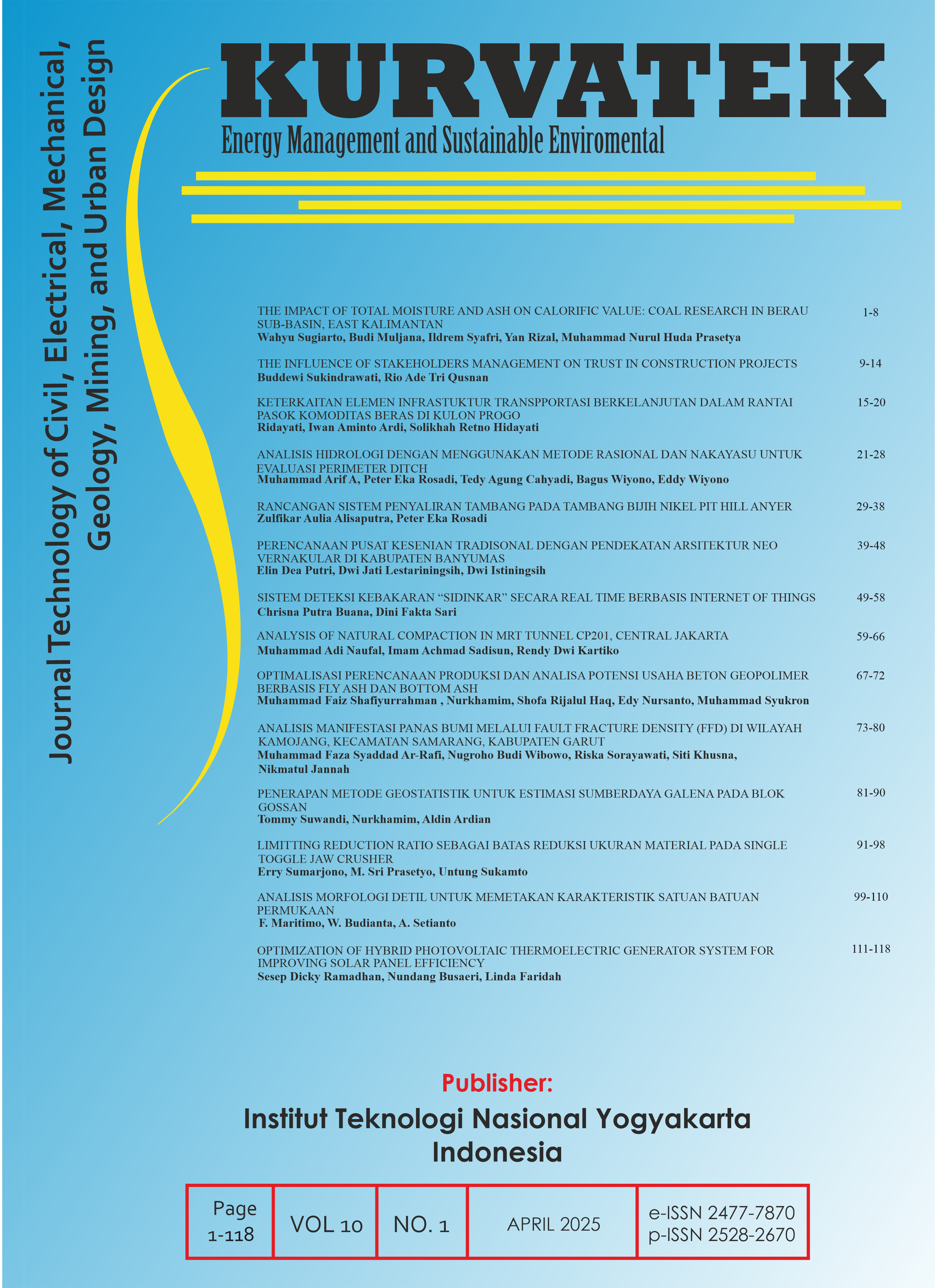LIMITTING REDUCTION RATIO AS THE SIZE LIMIT FOR MATERIAL REDUCTION OPERATIONS IN A SINGGLE TOGGLE JAW CRUSHER
DOI:
https://doi.org/10.33579/krvtk.v10i1.5723Keywords:
Crushing, Jaw Crusher, Mineral Processing, Reduction Ratio, ReduksiAbstract
Reduction Ratio (RR) can be used to estimate the size of product that can be produced by a crusher. The reduction ratio can be calculated in several ways. One calculation that can be done is calculating the Limitting Reduction Ratio (LRR). Limiting Reduction Ratio is a comparison between the largest feed size and the largest product size. This research aims to calculate the Limiting Reduction Ratio in clay stone crushing operations for 30 samples, which was carried out on a laboratory scale, using a single toggle jaw crusher type crusher. Crushed products are separated by hand sieving sizes +4#, 10#, 20#, 40#, 60#,100#, 200#. The research results show that the percentage of crushed products produced is still found in the largest sieve size, namely 4#, with an average amount of 52.33%. The largest feed size ranges from 24 mm to 27 mm and the largest product size ranges from 4 mm to 6 mm. The relationship between total feed weight and total product weight can be expressed in the equation Y = 0.5229 X and R2 = 0.9228, while the relationship between the largest feed size and the largest product size is expressed in the equation Y = 0.2044 X and R2 = 0.9761. The calculation of the limiting reduction ratio ranges from 4.2 to 6.8, with an average value of 5.02.
Keywords: Crushing, Jaw Crusher, Mineral Processing, Reduction Ratio, Reduksi
Downloads
References
J. M. Currie, Unit Operation in Mineral Processing, Coulombia : CSM Press, 1973.
B. M. Olaleye, “Influence of Some Rock Strength Properties on Jaw Crusher Performance in Granite Quarry”, Mining Science and Technology, vol. 20, no. 2, pp. 204-208, Maret 2010. doi.org/10.1016/S1674-5264(09)60185-X
G. Asbjörnsson, “Crushing Plant Dinamics”, Thesis for The Degree of Doctor Philosophy in Product and Production Development, Department of Product and Production Development, Chalmers, University of Technology, Göthenborg, Sweden, 2015.
B. H. G. Brady dan E.T. Brown, Rock Mass Structure. In: Rock Mechanics, Springer, Dordrecht, 1985. doi: doi.org/10.1007/978-94-011-6501-3_3
P. N. Mwangi, O. M. Muvengei, and T. O. Mbuya, “Review of Discrete Element Modelling in Optimisation of Energy Consumption of a Single-Toggle Jaw Crusher”, Proceeding of the Sustainable Research and Innovation Conference, JKUAT Main Campus, 2-4 May 2018, Kenya, 2018.
M. Lindqvist dan C. M. Evertsson, “Liner Wear in Jaw Crusher”, Minerals Engineering, vol. 16, no. 1, pp. 1-12, Januari 2003. doi: doi.org/10.1016/S0892-6875(02)00179-6
J. Drzymala, Mineral Processing, Foundation of Theory and Practice of Minerallurgy, 1st English Edition, Wroclaw University of Technology, p. 122, 2007.
C. Okechukwu, et al., “Design and Operation Challenges of a Single Toggle Jaw Crusher : a Review”, Nigerian Journal of Technology (NIJOTEC), vol. 36, no. 3, pp. 814-821, Juli 2017. doi: dx.doi.org/10.4314/njt.v36i3.22
B. A. Wills and T. J. Napier-Munn, Will’s Mineral Processing Technology, an Introduction to the Practical Aspect of Ore Treatment and Recovery. Queensland : 7th Edition, Elsevier Science & Technology Books, pp. 119-120, 2006.
M. Evertssson, ”Cone Crusher Performance”, Ph.D Thesis, Department of Machine and Vehicle Design, Chalmers, University of Technology, Göthenborg, Sweden, 2000.
E. Lee, “Optimization of Compressive Crushing”, Ph.D Thesis, Department of Product and Production Development, Chalmers, University of Technology, Göthenborg, Sweden, 2012.
S. R. Krogh, Crushing Characteristic. Powder Technology: 27. @Elsevier Seqoula S.A. Lausanne-Printed in Netherlands, 1980.
B. B. V. L. Deepak, ”Optimum Design an Analysis of (the) Swinging Jaw Plate of a Single Toggle Jaw Crusher”, Tesis, Department of Mechanical Engineering, National Institute Rourkela, p.3, 2010.
G. Kirankumar, Optimization of Jaw Crusher, Advance Research and Innovations in Mechanical, Material Science, Industrial Engineering and Management-ICCARMMIEM-2014, p. 238, 2014.
C. Okechkwu, O. A. Dahunsi, P. K. Oke, I. O. Oladele, M. Dauda, and B. M. Olaleye, “Design and Operations Challenges of a Single Toggle Jaw Crusher : a Review”, Nigerian Journal of Technologi (NIJOTECH), vol. 36, no. 3, pp. 814-815, Juy 2017. doi: dx.doi.org/10.4314/njt.v36i3.22
I. I. I. Beloglazov and A. Dmitrii, “Computer Simulation Methods for Crushing Process in an Jaw Crusher”, VII International Scientific Practical Conference Innovative Technologies in Engineering, IOP Publishing, p. 2, 2016.
D. Legendre and Zevenhoven, Assesing the Energy Efficiency of a Jaw Crusher., Article in Press, Elsevier, p.12, 2014.
A. Refahi, Mohandesi, J. Aghazadeh, and B. Rezai, “Comparison between Bond Crushing Energy and Fracture Energy of Rocks in a Jaw Crusher using Numerical Simulation”, The Journal of Southern African Institute of Mining and Metallurgy, p. 709, 2009.
M. S. Oduri, D. M. Munyasi, and S. W. Mutuli, “Analysis of the Single Toggle Jaw Crusher Force Transmissiin Characteristic”, Journal of Engineering, vol. 2016.
Downloads
Published
How to Cite
Issue
Section
License
Copyright (c) 2025 Erry Sumarjono, M. Sri Prasetyo Budi, Untung Sukamto

This work is licensed under a Creative Commons Attribution-ShareAlike 4.0 International License.
This journal provides immediate open access to its content on the principle that making research freely available to the public supports a greater global exchange of knowledge.
All articles published Open Access will be immediately and permanently free for everyone to read and download. We are continuously working with our author communities to select the best choice of license options, currently being defined for this journal as follows:
• Creative Commons Attribution-ShareAlike (CC BY-SA)

This work is licensed under a Creative Commons Attribution-ShareAlike 4.0 International License.










